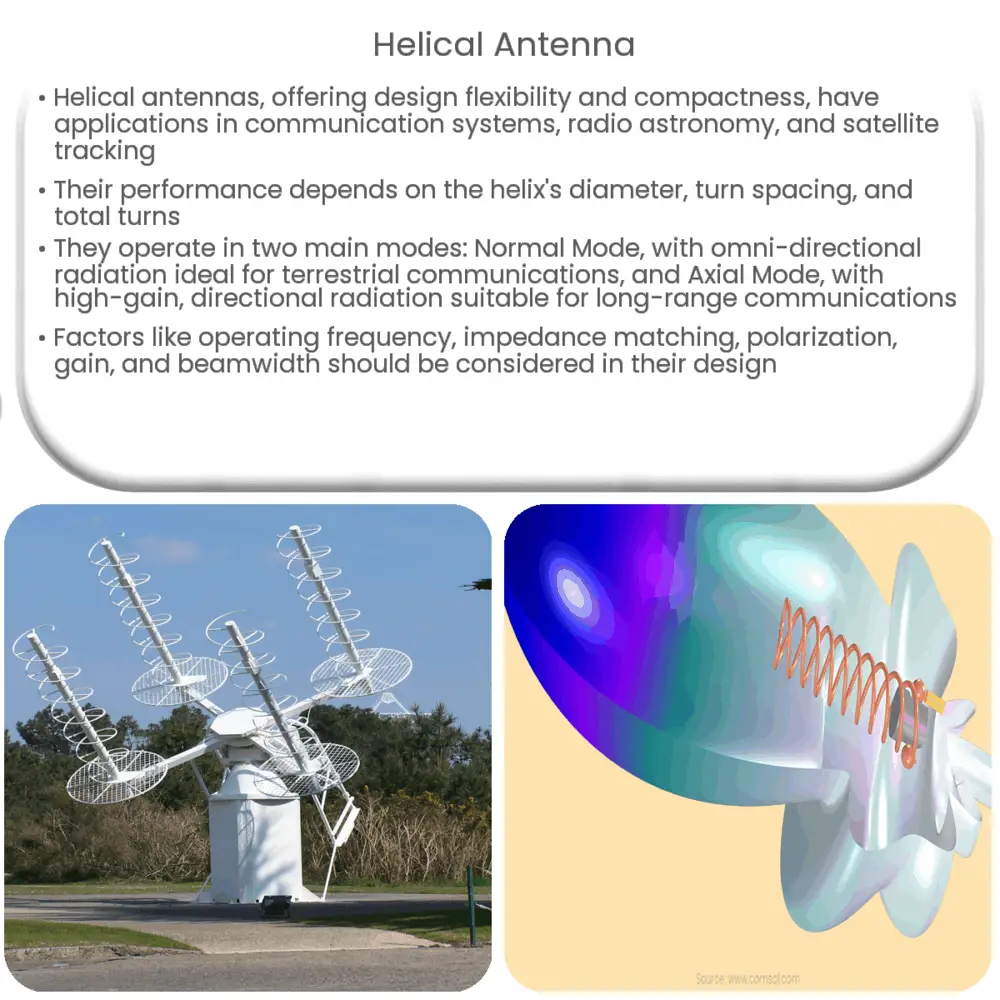Helical antennas are versatile, compact, and offer circular polarization, making them ideal for communication systems, satellite tracking, and radio astronomy.

Helical Antenna: A Comprehensive Overview
Introduction
Helical antennas, also known as helix antennas, have become increasingly popular due to their unique characteristics, which make them well-suited for various applications in communication systems, radio astronomy, and satellite tracking. This article aims to provide a comprehensive overview of helical antennas, their design principles, types, and applications.
Basic Principles of Helical Antenna
A helical antenna consists of a helically wound conducting wire that is mounted over a ground plane. The wire is wound in the shape of a helix or a screw, which gives the antenna its distinctive appearance. The helix is typically fed by a coaxial cable connected to the bottom of the helix. The antenna operates on the principle of electromagnetic radiation and receives/transmits signals in a circularly polarized manner, which helps in maintaining signal integrity in various environments.
The performance and radiation characteristics of a helical antenna are primarily influenced by three key parameters: the diameter of the helix (D), the spacing between turns (S), and the total number of turns (N). These parameters determine the antenna’s resonant frequency, gain, and beamwidth.
Types of Helical Antennas
Based on their radiation characteristics, helical antennas can be classified into two main types:
- Normal Mode Helical Antenna: In normal mode, the dimensions of the helix are small compared to the wavelength of the operating frequency. The antenna exhibits a predominantly omni-directional radiation pattern and is commonly used in terrestrial communication systems, such as mobile phones and wireless networks. The gain of a normal mode helical antenna is generally low, and its radiation pattern resembles that of a dipole antenna.
- Axial Mode Helical Antenna: In axial mode, the dimensions of the helix are comparable to or larger than the wavelength of the operating frequency. This results in a highly directional radiation pattern with significant gain, making axial mode helical antennas suitable for long-range communication, satellite tracking, and radio astronomy. The radiation pattern of an axial mode helical antenna resembles that of a parabolic reflector.
Design Considerations
When designing a helical antenna, it is crucial to consider the specific application and desired performance characteristics. The following factors should be taken into account:
- Operating Frequency: The resonant frequency of the antenna must be compatible with the intended application. This can be achieved by adjusting the dimensions of the helix, such as the diameter and spacing between turns.
- Impedance Matching: To ensure maximum power transfer between the antenna and the feeding system, proper impedance matching is required. This can be achieved through the use of a balun or other matching techniques.
- Polarization: Depending on the application, the antenna may need to transmit or receive signals with a specific polarization, such as linear, circular, or elliptical. The helical antenna’s polarization can be controlled by adjusting the helix’s dimensions and winding direction.
- Gain and Beamwidth: The gain and beamwidth of the antenna are important factors in determining its radiation characteristics. The desired gain and beamwidth can be achieved by varying the helix’s dimensions and the number of turns.
Advantages of Helical Antennas
Helical antennas offer several advantages over other types of antennas, which make them an attractive choice for a variety of applications:
- Flexibility in Design: The parameters of helical antennas can be easily adjusted to achieve the desired performance characteristics, such as gain, beamwidth, and polarization.
- Compactness: Helical antennas have a relatively small size compared to other high-gain antennas, making them ideal for space-constrained applications and portable devices.
- Circular Polarization: Helical antennas are inherently circularly polarized, which provides better signal integrity in multipath environments and reduces signal fading. This is particularly useful in satellite communication and mobile communication systems.
- Wideband Performance: Helical antennas can operate over a wide range of frequencies, making them suitable for broadband applications and frequency-hopping communication systems.
Common Applications of Helical Antennas
Helical antennas have been widely used in various fields due to their unique characteristics. Some of the most common applications include:
- Communication Systems: Helical antennas are commonly used in mobile phones, wireless networks, and other terrestrial communication systems due to their compact size, circular polarization, and omni-directional radiation pattern in normal mode.
- Satellite Tracking and Communication: Axial mode helical antennas, with their high gain and directional radiation pattern, are ideal for satellite tracking and communication systems. They are often used for ground stations, low earth orbit (LEO) satellite communication, and global positioning systems (GPS).
- Radio Astronomy: The high-gain and directional characteristics of axial mode helical antennas make them suitable for radio astronomy applications, such as radio telescopes and deep-space communication systems.
- Radar Systems: Helical antennas are used in various radar systems, including ground-penetrating radar and weather radar, due to their wideband performance and circular polarization.
Conclusion
Helical antennas offer a unique combination of design flexibility, compactness, circular polarization, and wideband performance, making them an excellent choice for a wide range of applications. With their ability to operate in both normal and axial modes, helical antennas can cater to different requirements, from terrestrial communication systems to satellite tracking and radio astronomy. As technology advances and communication systems continue to evolve, helical antennas will undoubtedly continue to play a significant role in the field of antenna engineering and design.

